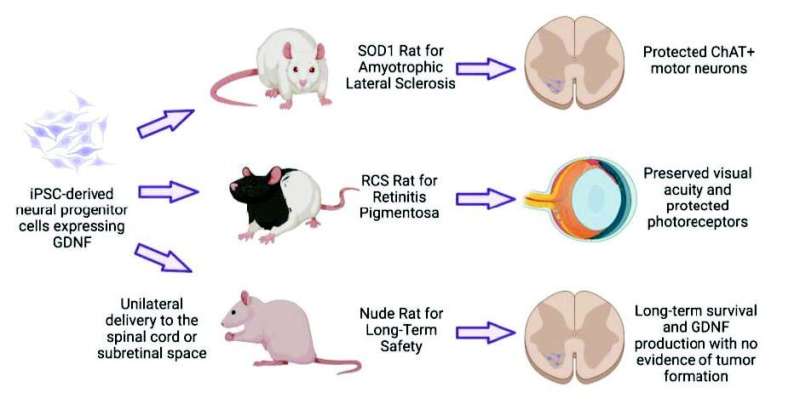This article has been reviewed according to Science X's editorial process and policies. Editors have highlighted the following attributes while ensuring the content's credibility:
fact-checked
peer-reviewed publication
proofread
A renewable, engineered cell product shows potential for treating neurodegenerative and retinal diseases

Progressive loss of neurons is the underlying cause for a diverse spectrum of severe diseases called neurodegenerative diseases, which include Parkinson's disease, amyotrophic lateral sclerosis (ALS) and retinitis pigmentosa. While strategies for regenerating or replacing lost neurons from stem cells are being developed, an alternative treatment option is the protection of existing neurons to prevent their degeneration, a recent study published in Stem Cell Reports suggests.
Researchers from Cedars-Sinai Medical Center, U.S., genetically engineered neural progenitor cells (NPCs), a type of cell that makes neurons and supporting brain cells called astrocytes, to release a specific neuroprotective protein, after a recent proof of principle clinical trial suggested that this approach is safe and possibly efficacious in patients with ALS.
Researchers Clive Svendsen and colleagues have taken this to the next level by making a potentially patient-specific source of engineered cells by generating engineered NPCs from reprogrammed adult human blood cells. The engineered NPCs were tested in two different animal models of neurodegenerative disease, where they effectively prevented the death of neurons in rat model of ALS as well photoreceptor (cells in the eye that respond to light) death in rats with retinal disease.
Strikingly, in the retinal disease rats, vision rapidly declined in untreated eyes but was preserved in eyes treated with engineered NPCs. Transplanted cells survived for up to nine months in the rat spinal cord where they continued to release the neuroprotective protein and turned into neuron-supporting astrocytes. This combination may be responsible for the observed therapeutic effects according to the researchers.
This study provides a strong rationale and support for future clinical trials on the safety and efficacy of engineered sustainable, patient-specific NPCs to treat neurodegenerative disease.
More information: Clive N. Svendsen & collegaues, Human iPSC-derived neural progenitor cells secreting GDNF provide protection in rodent models of ALS and retinal degeneration, Stem Cell Reports (2023). DOI: 10.1016/j.stemcr.2023.03.016. www.cell.com/stem-cell-reports … 2213-6711(23)00104-2




















